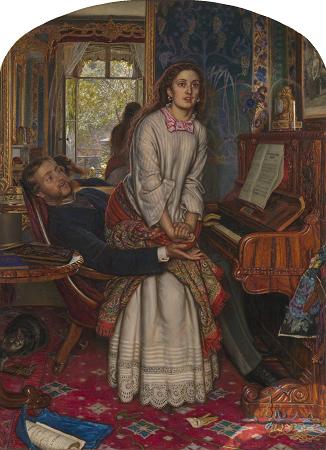Pre-Raphaelite Artist. The Pre-Raphaelite Brotherhood was a group of English painters, poets, and art critics, founded in 1848 by William Holman Hunt, John Everett Millais and Dante Gabriel Rossetti. The three founders were joined by William Michael Rossetti, James Collinson, Frederic George Stephens and Thomas Woolner to form the seven-member brotherhood. Their principles were shared by other artists, including Ford Madox Brown, Arthur Hughes and Marie Spartali Stillman. A later, medievalising strain inspired by Rossetti included Edward Burne-Jones and extended into the twentieth century with artists such as John William Waterhouse. The group's intention was to reform art by rejecting what it considered the mechanistic approach first adopted by Mannerist artists who succeeded Raphael and Michelangelo. Its members believed the Classical poses and elegant compositions of Raphael in particular had been a corrupting influence on the academic teaching of art, hence the name Pre-Raphaelite. In particular, the group objected to the influence of Sir Joshua Reynolds, founder of the English Royal Academy of Arts, whom they called Sir Sloshua. To the Pre-Raphaelites, according to William Michael Rossetti, sloshy meant anything lax or scamped in the process of painting. and hence. any thing or person of a commonplace or conventional kind. The brotherhood sought a return to the abundant detail, intense colours and complex compositions of Quattrocento Italian art. The group associated their work with John Ruskin, an English critic whose influences were driven by his religious background. The group continued to accept the concepts of history painting and mimesis, imitation of nature, as central to the purpose of art. The Pre-Raphaelites defined themselves as a reform movement, created a distinct name for their form of art, and published a periodical, The Germ, to promote their ideas. The group's debates were recorded in the Pre-Raphaelite Journal. The Pre-Raphaelite Brotherhood was founded in John Millais's parents' house on Gower Street, London in 1848. At the first meeting, the painters John Everett Millais, Dante Gabriel Rossetti, and William Holman Hunt were present. Hunt and Millais were students at the Royal Academy of Arts and had met in another loose association, the Cyclographic Club, a sketching society. At his own request Rossetti became a pupil of Ford Madox Brown in 1848. At that date, Rossetti and Hunt shared lodgings in Cleveland Street, Fitzrovia, Central London. Hunt had started painting The Eve of St. Agnes based on Keats's poem of the same name, but it was not completed until 1867. As an aspiring poet, Rossetti wished to develop the links between Romantic poetry and art. By autumn, four more members, painters James Collinson and Frederic George Stephens, Rossetti's brother, poet and critic William Michael Rossetti, and sculptor Thomas Woolner, had joined to form a seven-member-strong brotherhood. Ford Madox Brown was invited to join, but the more senior artist remained independent but supported the group throughout the PRB period of Pre-Raphaelitism and contributed to The Germ. Other young painters and sculptors became close associates, including Charles Allston Collins, and Alexander Munro. The PRB intended to keep the existence of the brotherhood secret from members of the Royal Academy. The brotherhood's early doctrines, as defined by William Michael Rossetti, were expressed in four declarations: to have genuine ideas to express;. to study Nature attentively, so as to know how to express them;. to sympathise with what is direct and serious and heartfelt in previous art, to the exclusion of what is conventional and self-parading and learned by rote; and. most indispensable of all, to produce thoroughly good pictures and statues. The principles were deliberately non-dogmatic, since the brotherhood wished to emphasise the personal responsibility of individual artists to determine their own ideas and methods of depiction. Influenced by Romanticism, the members thought freedom and responsibility were inseparable. Nevertheless, they were particularly fascinated by medieval culture, believing it to possess a spiritual and creative integrity that had been lost in later eras. The emphasis on medieval culture clashed with principles of realism which stress the independent observation of nature. In its early stages, the Pre-Raphaelite Brotherhood believed its two interests were consistent with one another, but in later years the movement divided and moved in two directions.
more...














